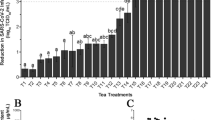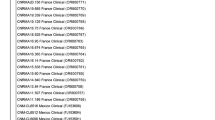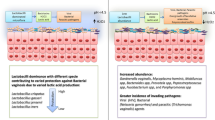Abstract
The aims of this study were to identify the bacterial genera and species present in semen of Apis mellifera and to evaluate the sensitivity of those bacteria to different antibiotics. Mesophilic aerobic and microaerophilic bacteria were characterized in semen samples from different hives, and the number of total viable bacteria per milliliter of semen was determined. Twenty-nine isolates were obtained, and 14 different genera were identified, some of them being monomicrobians and others polymicrobians. Colony-forming units (CFU) were variable from no bacterial development up to 4 × 105 CFU/mL. The most frequent genera were Bacillus and Staphylococcus. All the studied isolates were sensitive to gentamicin and amikacin. Spermatozoa viability in sperm samples diluted in buffer with antibiotic was similar to that of pure semen.
Similar content being viewed by others
References
Abro, S.H., Wagan, R., Tunio, M.T., Kamboh, A.A., Munir, M. (2009) Biochemical activities of bacterial species isolated from the frozen semen of cattle. J. Agric. Soc. Sci. 5, 109–113
Akhter, S., Ansari, M.S., Andrabi, S.M.H., Ullah, N., Qayyum, M. (2008) Effect of antibiotics in extender on bacterial and spermatozoal quality of cooled buffalo (Bubalus bubalis) bull semen. Reprod Dom. Anim. 43, 272–278
Allipi, A.M. (1995) Detection of Bacillus larvae spores in Argentinian honeys by using a semi-selective medium. Microbiol. SEM 11, 343–350
Althouse, G.C. (1999) Orígenes y efectos de la contaminación microbiológica en el semen porcino conservado. Anaporc 192, 83–94
Althouse, G.C., Lu, K.G. (2005) Bacteriospermia in extended porcine semen. Theriogenology 63, 573–584
Althouse, G.C., Kuster, C.E., Clark, S.G., Weisiger, R.M. (2000) Field investigations of bacterial contaminants and their effects on extended porcine semen. Theriogenology 53, 1167–1176
Andere, C., Capel, A.M., Palacio, M.A., Catena, M., Martínez, A., Rodríguez, E.M., Collins, A.M. (2008) Evaluación de calidad seminal de zánganos de Apis mellifera para su uso en inseminación instrumental. InVet. 10(1), 142
Aurich, C., Spergser, J. (2007) Influence of bacteria and gentamicin on cooled-stored stallion spermatozoa. Theriogenology 67, 912–918
Bielanski, A., Bergeron, H., Lau, P.C., Devenish, J. (2003) Microbial contamination of embryos and semen during long term banking in liquid nitrogen. Cryob. 46, 146–152
Biosafety in Microbiological and Biomedical Laboratories. (2007) In: Wilson, D.E., and L.C. Chosewood (Eds.), 5th ed., U.S. Department of Health and Human Services, Centers for Disease Control and Prevention and National Institutes of Health, Fifth Edition, U. S. Government Printing Office, Washington, [online] http://www.cdc.gov/od/ohs/biosfty/bmbl5/bmbl5toc.htm (accessed on 18 March 2009).
Brenner, D.J. (1984) Enterobacteriaceae. In: Krieg, N.R., Holt, J.G. (eds.) Bergey’s Manual of Systematic Bacteriology. Williams & Wilkins, Baltimore
Brenner, D.J. (2005) The Proteobacteria-Parts A-C. In: Garrity, G.M., Krieg, N.R., Staley, J.T. (eds.) Bergey’s Manual of Systematic Bacteriology, Volume Two, 2nd edn. Springer, Verlag
Catena, M., Cabodevila, J. (1999) Evaluación de semen bovino congelado. Taurus. 1, 18–31
Catena, M., Cabodevila, J., Soto, P., Sparo, M., Monteavaro, C., Ens, P. (1998) Aislamientos bacteriológicos en semen bovino congelado. Rev. Vet. Arg. 15, 558–563
CLSI (2008) Performance Standards for Antimicrobial Susceptibility Testing. 18th, Informational Supplement, M100-S18. Clinical and Laboratory Standars Institute, Wayne
Cobey, S.W. (1983) The development of instrumental insemination. Am. Bee. J. 123, 108–111
Cobey, S.W. (2007) Comparison studies of instrumentally inseminated and naturally mated honey bee queens and factors affecting their performance. Apidologie 38, 390–410
Collins, A.M., Donoghue, A.M. (1999) Viability assessment of honey bee, Apis mellifera, sperm using dual fluorescent staining. Theriogenology 51, 1513–1523
Cowan and Steel’s (1999) In: Barrow, G.I., Feltham, R.K.A. (eds.) Manual for the identification of medical bacteria, 3rd edn. Cambridge University Press, United Kingdom
Cruz Höfling, M.A., Cruz, L.C., Kitajima, E. (1970) The fine structure of spermatozoa from the honeybee. An. Acad. Brasil. Cienc. 42, 69–78
Cruz-Landim, C., Cruz Höfling, M.A. (1969) Electron microscope observations on honeybee seminal vesicles (Apis mellifera adansonii, Hymenoptera, Apidae), Papéis Avulsos de Zool. (S. Paulo) 22, 1–11.
Eaglesome, M.D., Garcia, M.M., Stewart, R.B. (1992) Microbial agents associated with bovine genital tract infections and semen, Part I Brucella abortus, Leptospira, Campylobacter fetus and Tritrichomonas foetus. Vet. Bull. 62, 743–769
Gadea, J. (2003) Review: Semen extenders used in the artificial insemination of swine. Spanish J. Agric. Res. 1, 17–27
García, G.D., Rojas Mogollon, M.A., Sanchez, N.J. (2006) Contenido microbiológico cultivable del tracto intestinal y polen almacenado de Apis mellifera (Hymenoptera: Apidae). Acta biol Colomb. 11, 123–129
Gilliam, M. (1971) Microbial sterility of the intestinal content of the immature honey bee, Apis mellífera. Ann. Entomol. Soc. Am. 64, 315–316
Gilliam, M. (1978) Bacteria belonging to the genus Bacillus isolated from selected organs of queen honey bees Apis mellífera. J. Invertebr. Pathol. 31, 389–391
Gilliam, M. (1979) Microbiology of pollen and bee bread, the genus Bacillus. Apidologie 10, 269–274
Gilliam, M. (1997) Identification and roles of non-pathogenic microflora associated with honeybees, FEMS. Microbiology Letters 155(1), 1–10
Gilliam, M., Lorenz, B.J. (1983) Gram-positive cocci from apiarian sources. J. Invertebr. Pathol. 42, 187–195
Gilliam, M., Prest, D.B. (1987) Microbiology of feces of the larval honey bee Apis mellífera. J. Invertebr. Pathol. 49, 70–73
Gilliam, M., Taber, S. (1991) Diseases, pest and normal microflora of honeybees, Apis mellífera from feral colonies. J. Invertebr. Pathol. 58, 286–289
Gilliam, M., Valentine, D.K. (1974) Enterobacteriaceae isolated from foraging worker honey bees Apis mellífera. J. Invertebr. Pathol. 23, 38–41
Gilliam, M., Valentine, D.K. (1976) Bacteria isolated from the intestinal contents of foraging of worker honey bee Apis mellifera: the genus bacillus. J. Invertebr. Pathol. 28, 275–276
Gilliam, M., Lorenz, B.J., Richardson, G.V. (1988) Digestive enzymes and micro-organisms in honey bees, Apis mellifera: influence of streptomycin, age, season and pollen. Microbios 55, 95–114
Giraldi, G.L. (1991) Pseudomonas and related genera. In: Balows, A., Hauster, W.J., Herrmann, K.L., Isenberg, H.D., Shadomy, H.J. (eds.) Manual of Clinical Microbiology, pp. 429–441. American Society for Microbiology: Washington
Harbo, J.R. (1985) Instrumental insemination of queen bees–part 1 & 2. Am Bee J. 125(197–202), 282–287
Jeyaprakash, A., Hoy, M.A., Allsopp, M.H. (2003) Bacterial diversity in worker adults of Apis mellifera capensis and scutellata (Insecta: Hymenoptera) assessed using 16S rRNA sequences. J. Invertebr. Pathol. 84, 96–103
Johnson, L.A., Aalbers, J.G., Wilems, C.M., Rademaker, T.J.H.M., Rexroad Jr., C.E. (1982) Use of boar spermatozoa for artificial insemination III, Fecundity of boar spermatozoa stored in Beltsville liquid and Kiev extenders for three days at 18°C. J. Anim. Sci. 54, 132–136
Kacániová, M., Chlebo, R., Kopernický, M., Trakovická, A. (2004) Microflora of the honeybee gastrointestinal tract. Folia Microbiol. 49, 169–171
Kapoor, S. (2003) Isolation of aerobic bacteria in frozen semen of cattle and buffaloes. Ind. J. Com. Microbiol. Immunol. Infect. Dis. 24, 207–208
Kirby, W.M.M., Bauer, A.W., Sherris, J.C., Turck, M. (1966) Antibiotic susceptibility testing by a standardized single disc method. Am. J. Clin. Pathol. 45, 493–496
Lensky, Y., Schindler, H. (1979) Ultrastructure of the spermatozoon of the mature drone honeybee. J. Apic. Res. 18, 264–271
Lino-Neto, J., Báo, S.N., Dolder, H. (2000) Sperm ultrastructure of the honey bee bee (Apis mellífera) (L) (Hymenoptera, Apidae) with emphasis on the nucleus-flagellum transition region. Tissue & Cell 32, 322–327
Little, R.C., Milliken, G.A., Strup, W.W., Wolfinger, R.D. (1996) SAS System for Mixed Models. SAS Institute Inc, Cary
Locke, S.J., Peng, Y.S. (1993) The effects of drone age, semen storage and contamination on semen quality in the honey bee (Apis mellifera). Physiol. Entomol. 18, 144–148
Locke, S.J., Peng, Y., Cross, N.L. (1990) A supravital staining technique for honey bee spermatozoa. Physiol. Entomol. 15, 187–192
Mac Faddin, J.F. (2000) Biochemical Test for Identification of Medical Bacteria, 3rd edn. Lippincott Williams and Wilkins, Baltimore
Mackensen, O. (1950) Viability and sex determination in the honey bee (Apis mellifera L.). Genetics. 36, 501–509
Martínez, R. (1998) Principales factores que afectan la reproducción del cerdo. Rev. Ciencia Vet. 8, 187–222
Mazurova, J., Vinter, P. (1991) The effect of selected antibiotics on microorganisms contaminating boar ejaculate. Vet. Med. 36, 213–223
Mazzilli, F., Delfino, M., Imbrogno, N., Elia, J., Dondero, F. (2006) Survival of micro-organisms in cryostorage of human sperm. Cell Tiss Bank 7, 75–79
McGahon, A., Martin, S., Bissonnette, R., Mahboubi, A., Shi, Y., Mogil, R., Nishioka, W., Green, D. (1995) The end of the (cell) line: methods for the study of apoptosis in vitro. Methods Cell Biol. 46, 153–185
Moors, L., Spaas, O., Koeniger, G., Billen, J. (2005) Morphological and ultrastructural changes in the mucus glands of Apis mellifera drones during pupal development and sexual maturation. Apidologie 36, 245–254
Moritz, R.F.A. (1984) The effect of different diluents on insemination success in the honeybee using mixed semen. J. Apic. Res. 23, 164–167
National Committee for Clinical Laboratory Standards (2000) Methods for Dilution Antimicrobial Susceptibility Tests for Bacteria that Grow Aerobically, Fifth Edition, Approved Standard M7-A5. NCCLS, Wayne
Otti, O., Naylor, R.A., Siva-Jothy, M.T., Reinhardt, K. (2009) Bacteriolytic activity in the ejaculate of an insect. Am. Nat. 174, 292–295
Page, R. (1986) Sperm utilization in social insects. Ann. Rev. Entomol. 31, 297–320
Palacio, M.A., Figini, E., Andere, C.I., Bedascarrasbure, E.L. (2003) Programa de Mejoramiento Genético: Material Vivo de Calidad. IDIA XXI 5, 28–31
Peng, Y.S., Locke, S.J., Nasr, M.E., Liu, T.P., Montague, M.A. (1990) Differential staining for live and dead sperm of honey bees. Physiol. Entomol. 15, 211–217
Piccini, C., Antunez, K., Zunino, P. (2004) An approach to the characterization of the honey bee hive bacterial flora. J. Apic. Res. 43, 101–104
Pineda, Y., Santander, J. (2007) Evaluación de la flora bacteriana del semen de verracos en granjas porcinas de Venezuela. Zootec. Trop. 25, 173–177
Poole, H.K., Taber, S. (1970) In vitro preservation of honeybee semen enhanced by storage at 13–15°C. Ann. Ent. Soc. Amer. 63, 1673–1674
Qureshi, Z.I., Ala-Ud-Din, L.L.A., Sahahid, R.U., Naz, N.A. (1993) Comparative effect of different levels of gentamicin in viable bacterial count of cow bull semen. J. of Islamic Academy of Sci. 6, 114–117
Román, J.C., García, P.C. (2005) Retrato Microbiológico. Arcanobacterium haemolyticum. Ver. Chil. Infect. 22, 355
Russell, P.H., Lyaruu, V.H., Millar, J.D., Curry, M.R., Watson, P.F. (1997) The potential transmission of infectious agents by semen packaging during storage for artificial insemination. Anim. Reprod. Sci. 47, 337–342
Schlüns, H., Schlüns, E.A., Van Praagh, J., Moritz, R.F.A. (2003) Sperm numbers in drone honeybees (Apis mellifera) depend on body size. Apidologie 34, 577–584
Snowdon, J., Cliver, D. (1996) Microorganisms in honey. Int. J. Food Microbiol. 31, 1–26
Sone, M. (1982) Effects of various antibiotics on the control of bacteria in boar semen. Vet. Rec. 111, 11–14
Toniolli, R., Ferreira, R.F., Capibaribe, P.J., Queiroz, D.B., Sampaio, B.S. (2002) Diferentes tipos de higienización del verraco y su influencia sobre la calidad bacteriológica del eyaculado. Rev. Prod. Anim. 13, 81–84
Williams, J.L., Harbo, J.R. (1982) Bioassay for diluents of honey bee semen. Ann. Entomol. Soc. Am. 75, 457–459
Acknowledgments
We would like to thank Analía Martínez for collection of the semen for this work, Susana Insúa for technical assistance, and Dr. Carolina Bianchi for the comprehensive lecture and suggestions. This study received financial support from the PROAPI (Integrated Project for Beekeeping Development).
Sperme d ’ Apis mellifera : contamination bactérienne et sensibilité aux antibiotiques.
Apis mellifera / sperme / contenu bactérien / sensibilité aux antibiotiques
Apis mellifera Sperma: Kontamination mit Bakterien und Empfindlichkeit gegenüber Antibiotika
Apis mellifera / Sperma / Bakteriengehalt / Antibiotikaempfindlichkeit
Author information
Authors and Affiliations
Corresponding author
Additional information
Manuscript editor: David Tarpy
Rights and permissions
About this article
Cite this article
Andere, C.I., Monteavaro, C., Palacio, M.A. et al. Apis mellifera semen: bacterial contamination and susceptibility to antibiotics. Apidologie 42, 551–559 (2011). https://doi.org/10.1007/s13592-011-0051-7
Received:
Revised:
Accepted:
Published:
Issue Date:
DOI: https://doi.org/10.1007/s13592-011-0051-7




